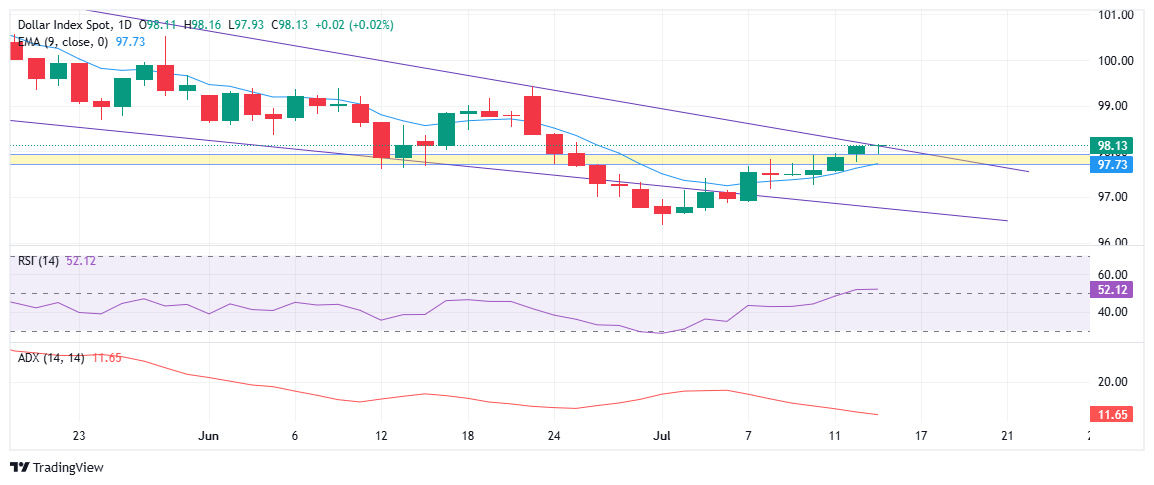US Dollar edges higher as June CPI reinforces Fed’s cautious stance

The US Dollar (USD) rises sharply on Tuesday following the release of the June Consumer Price Index (CPI) report. While gains remain modest, the Greenback is finding some support as the data showed headline inflation in line with expectations, but core inflation came in slightly softer than forecast. The figures reinforced the view that while price pressure remains persistent, the Federal Reserve (Fed) may still take a cautious approach on rate cuts, keeping the prospect of policy easing on hold for now.
The US Dollar Index (DXY) is gaining momentum, trading near 98.30 during the American trading session. While the index remains supported, it faces a confluence of key technical resistance at current levels. The broader market tone stays cautious amid ongoing tariff threats from US President Donald Trump.
The US CPI report revealed a sharper pickup in price pressures for June. Headline inflation rose by 0.3% on a monthly basis — the largest increase in five months — bringing the annual rate up to 2.7% from 2.4% in May. Both readings were in line with market expectations. However, Core CPI, which excludes volatile food and energy components, increased by 0.2% MoM, below the forecast of 0.3% and up slightly from the 0.1% gain in May. On an annual basis, core inflation ticked higher to 2.9% from 2.8%, signaling persistent underlying price pressures despite the softer monthly print.
The report showed firm price gains across energy, transportation, and tariff-affected sectors, suggesting trade-related inflation is beginning to flow through to consumers.
Fed Chair Jerome Powell has clearly stated that uncertainty over the impact of tariffs is one of the main reasons why the central bank has held off on cutting interest rates. Powell highlighted that the Fed “went on hold when we saw the size of the tariffs,” and now intends to assess how deeply tariffs will filter through to consumer prices and growth before easing monetary policy.
While some Fed officials believe the tariffs may cause only a temporary rise in prices, many are worried that the inflation effects could be more lasting, making it harder for the Fed to lower rates in the near term.
Market Movers: Trump doubles down on tariffs and criticism of Fed Powell
Technical Analysis: DXY recovery stalls, CPI may drive next move
The US Dollar Index(DXY) is trading near the 98.00 psychological level as investors await the release of the June CPI report.
Over the past two weeks, the index has been recovering steadily, supported by the 9-day moving average at 97.70. The price is currently testing the upper boundary of the wedge near 98.00, but bullish momentum appears tentative ahead of the inflation data. Bulls would need a strong push, possibly from a hotter-than-expected CPI report, to decisively break above 98.00 and reinforce the short-term bullish correction. If that happens, we could see the DXY head toward the 98.80-99.00 zone in the near term.
Momentum indicators reflect a cautious tone. The Relative Strength Index (RSI) is hovering flat around the neutral 50 level, indicating a lack of strong buying interest.
Meanwhile, the Average Directional Index (ADX) remains weak at 11.64, reflecting a lack of clear trend strength.
Overall, any big moves hinge on the upcoming inflation data. A hotter-than-expected CPI reading could provide the fuel needed for a bullish breakout above wedge resistance, reinforcing the case for reduced Fed interest rate-cut expectations and lifting the Greenback. Conversely, a softer CPI print may trigger a pullback, with immediate downside support seen near the 9-day EMA at 97.70 and the lower wedge boundary near 96.50.
US Dollar PRICE Today
The table below shows the percentage change of US Dollar (USD) against listed major currencies today. US Dollar was the strongest against the Japanese Yen.
The heat map shows percentage changes of major currencies against each other. The base currency is picked from the left column, while the quote currency is picked from the top row. For example, if you pick the US Dollar from the left column and move along the horizontal line to the Japanese Yen, the percentage change displayed in the box will represent USD (base)/JPY (quote).









_300xx250.jpg)
0 댓글